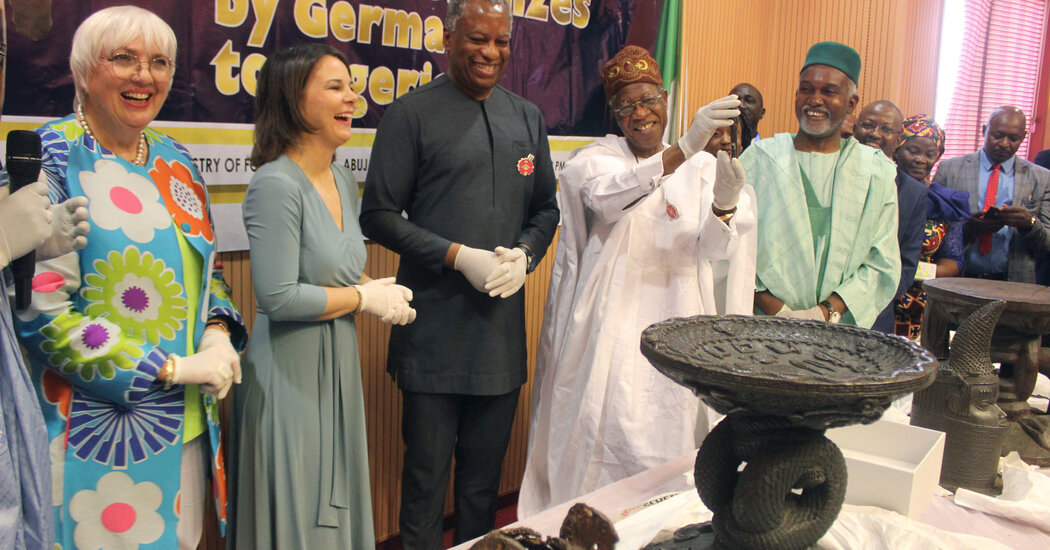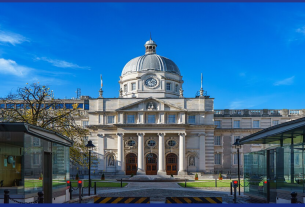When the airplane of Germany’s foreign minister touched down in Abuja, Nigeria, this past weekend, it carried precious cargo: 20 Benin Bronzes, priceless artifacts that were looted in a violent raid more than a century ago, and which were finally coming home.
At a ceremony in Abuja on Tuesday, the German official, Annalena Baerbock, handed the stolen items back to Nigerian officials. “It was wrong to take the bronzes, and it was wrong to keep them for 120 years,” she said.
In a legal sense, the 20 artifacts Baerbock brought with her belonged to Nigeria even before she took off from Berlin; more than 1,100 bronzes in German museums have become Nigerian property since the countries signed an agreement in July. But Tuesday’s handover was an important symbolic gesture, and many more of the artifacts are expected to come back to Nigeria next year. Others will remain in Germany on long-term loan.
The foreign minister’s trip is the culmination of a yearslong process that upended Germany’s approach to handling cultural items unjustly obtained during the colonial period. It is also part of a pioneering model for large-scale restitution, in which ownership is swapped before any artifacts change hands. Crucially, that approach allows for items to be restituted even if the country of origin does not yet have the facilities to store and exhibit them.
Baerbock described the return of the bronzes as “just the first step.”
“More of these agreements will follow,” she said. “And this moment is also historic to us. We are facing up to our history of colonialism.”
The bronzes consist of thousands of sculptures and plaques that British forces looted from Benin City, in what is now southern Nigeria, during a raid in 1897. Many wound up in museums around the world, including the Metropolitan Museum of Art, in New York; the British Museum, in London; and several major German institutions.
Nigeria has been calling for the objects’ return for several decades, and its deal with Germany is the largest yet. It is also notable because the effort was spearheaded not by individual museums, but by a national government.
The items returned on Tuesday included an 18th-century throne stool and a sculpture commemorating a Benin “oba,” or king. A pavilion to store and display the treasures is being built in Benin City and will most likely be completed in 2023. The building will be next to the planned Edo Museum of West African Art, an ambitious institution designed by the acclaimed Ghanaian British architect David Adjaye.
This outcome had seemed far-fetched as recently as five years ago. As in other European countries, the subject of restitution had been largely ignored in Germany until recently, and some museum leaders had been reluctant to part ways with artifacts.
The about-face was driven — as interviews with eight German and Nigerian officials showed — by a changing social consensus about the ethics of holding on to such items, and further strengthened by a backlash against Germany’s flagship cultural project: the Humboldt Forum, an $825 million institution in Berlin, conceived as Germany’s equivalent to the Louvre or the British Museum.
According to Andreas Görgen, the secretary general of Germany’s Federal Culture Ministry and one of the architects of the restitution agreement, the deal was also a testament to a careful, incremental strategy, which he contrasted with a flashier approach from France.
In 2017, the French president, Emmanuel Macron, gave a groundbreaking speech during a visit to Burkina Faso in which he pledged to make returning unjustly acquired items to African countries “a top priority.” Although some objects have been given back, the French effort has floundered, in part because museum objects are property of the French state, meaning Parliament must sign off on transfers of ownership.
“Macron took the very French route: a great speech by a great president, then it takes years for reality to match those words,” Görgen said. “We are operating in a German way,” he said. “It isn’t especially sexy, but it can be efficient.”
Germany’s approach also contrasts with those of the United States and British governments, which have left decisions up to individual institutions. Some organizations, including the Smithsonian Institution, have acted alone. Last month, the Horniman Museum, in London, held a ceremony to transfer ownership of 72 objects, including bronzes, to Nigeria’s government, and immediately returned six to Nigerian hands. A museum spokeswoman said the other 66 items would stay in London, on loan from Nigeria, for at least the next year.
Yet some of the most important museums in England cannot return their Benin Bronzes, even if they wanted to, without a change in the law. That includes the British Museum, which owns about 900 of the artifacts, arguably the world’s finest collection.
According to officials in Germany, a key turning point there occurred in 2019, amid growing public pressure. It was partly spurred by Macron’s speech and a rising awareness in Germany of its own colonial crimes — including the killing of tens of thousands of Nama and Herero people in what is now Namibia. The atrocity, carried out between 1904 and 1908, is widely seen as the first genocide of the 20th century.
Until then, the main vehicle for discussing the return of the Benin Bronzes had been the Benin Dialogue Group, a network founded in 2010 that brought together Nigerian representatives and figures from European museums with bronzes in their collections. The group, however, favored loans over transfers of ownership.
Some prominent German museum officials were already on the record opposing complete restitution. In an interview with Der Tagesspiegel in 2018, Hermann Parzinger, the president of the Prussian Cultural Heritage Foundation, which held the largest collection of Benin Bronzes in the country, said, “It is too simple to say that they were all stolen and to send them back.” He added, “Politicians should not try to outdo each other with pronouncements.”
Parzinger was among those overseeing the construction of the Humboldt Forum, a controversial project uniting several museums’ collections in a reconstructed Baroque palace in the center of Berlin. Although many Germans initially bristled at the project because it required the demolition of the former East German Parliament, which was seen as an act of historical erasure, that anger soon refocused on the provenance of many objects to be exhibited in the building, including about 500 Benin Bronzes.
In 2017, Bénédicte Savoy, a historian who advised Macron on restitution, resigned from the Humboldt Forum’s advisory board in protest, comparing the project to the Chernobyl nuclear accident site. Jürgen Zimmerer, a historian at the University of Hamburg, accused the Humboldt Forum’s leaders, including Parzinger, of having “colonial amnesia.”
As public anger mounted, German lawmakers began looking for ways to salvage the country’s most ambitious cultural project in decades.
According to Zimmerer, a key moment occurred in February 2019, when Angela Merkel, Germany’s chancellor at the time, invited a small number of historians and experts to a dinner to discuss restitution. Zimmerer recalled telling Merkel that an agreement with Nigeria about the bronzes needed to be reached before the Humboldt Forum’s upcoming opening, lest “the spotlight of the entire world” be focused on criticism of the project. He recalled her saying later that evening, “Then why don’t we give them back?” (A spokeswoman for the former chancellor declined to comment.)
Germany’s federal and state culture ministers convened the following month to approve guidelines for handling museum items from “colonial contexts.” The agreement stipulated that all objects that had been obtained “unethically” would be liable for return and directed institutions to facilitate claims by producing publicly available inventories.
Those guidelines also overruled reluctant museum leaders. “Society applied the pressure on the politicians,” Zimmerer said, “and the politicians applied the pressure on the museums.” He argued that the sudden rise in public support for restitution had been enhanced by an awareness of earlier moves to return artwork stolen by the Nazis. “People know that looted art is something you give back,” Zimmerer said.
In an interview, Parzinger, the museum official, explained his own change of heart. “The Benin Bronzes are so symbolic for colonial-era cultural theft that one cannot simply push it away,” he said.
A group under the leadership of Markus Hilgert, a leading cultural official representing Germany’s 16 states, began working on an online catalog listing the bronzes being held in disparate collections. “Objects are often not inventoried or digitalized, and it raised the question of how you can have a dialogue with a country of origin when you don’t even know what is in Germany,” Hilgert said. The resulting database, he said, “was the material foundation for taking up conversations with Nigeria.”
As the Germans signaled they were moving toward restitution, obstacles remained on the Nigerian side. Although the country had requested the return of the bronzes since the 1970s, there was conflict over who would take ownership of the artifacts. Both the Nigerian government and the oba of Benin, whose family ruled the historical Kingdom of Benin from which they were looted, claimed that they owned the items. Godwin Obaseki, the governor of Edo State, where Benin City is, said he acted as a facilitator to resolve the dispute.
“Things happened so quickly that we couldn’t get everybody on the same page fast enough,” Obaseki said.
Nigeria also lacked the facilities to safely store and exhibit the delicate items. Phillip Ihenacho, a Nigerian financier, said that in 2019, Obaseki asked him to find a solution to the country’s “deficit in museum infrastructure.” He noted that “there was pressure from the German end.”
Ultimately, he said, the oba’s family, Nigeria’s museum commission and the government of Edo State agreed to join a trust together, with independent directors that oversee the construction and operation of the new museum.
Görgen, the culture ministry official, said the announcement of the museum plans in late 2020 helped eradicate any remaining doubts in Germany. After several rounds of negotiations in the spring of 2021, Germany and Nigeria signed a “memorandum of understanding,” and then the official agreement in July 2022. The agreement was finalized weeks ahead of the opening of the Humboldt Forum’s ethnological exhibits.
Visitors to the Humboldt Forum can still view several dozen Benin Bronzes, accompanied by signage clarifying that the objects belong to Nigeria. According to Parzinger, the agreement allows for 168 pieces chosen by Nigeria’s museum commission to remain in Germany “so that Benin’s art can be shown to the world.” The approximately 350 other bronzes that were part of the Berlin museum collections will be transported to Nigeria once the pavilion is completed.
Officials in Benin City hope the return of the artifacts and the construction of the Edo Museum of West African Art will herald a cultural revival and a boom in tourism. Obaseki, the Edo governor, said its effects would ideally resemble those of the Guggenheim Museum in Bilbao, Spain, which is credited with transforming the fortunes of that formerly gritty port city.
Ihenacho, however, made it clear that the bronzes’ return brought with it a new set of practical challenges for Nigeria. It remains unclear who will pay for the shipment and insurance of the remaining items in Germany, and he noted that the bronzes’ storage and upkeep will come at a considerable cost, including electrical bills for climate control. “These objects are going to cost a lot of money, so you had better be prepared,” Ihenacho said, noting that the country’s museum infrastructure was still being built up.
“To the West, this story is very much about the return of the Benin Bronzes,” Ilhenacho said, “but for most Nigerians, this is the beginning.”



